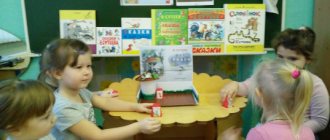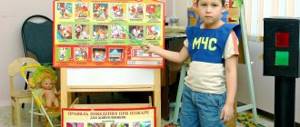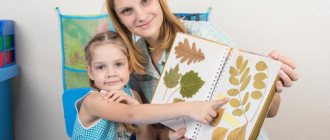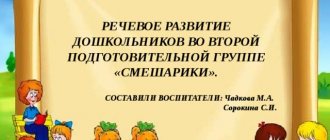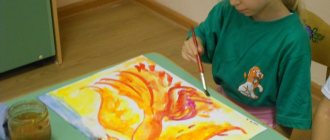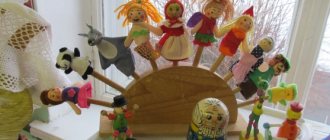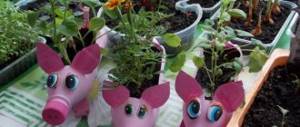A short-term project was carried out in middle group No. 3, children aged 4-5 years, on the topic “Healthy food”. The duration of the project is 1 week.
Project goal : expanding the knowledge of 4-5 year old children about food products (description of the product, its beneficial properties, method or place of obtaining it, preparing dishes from it).
Project objectives:
- develop oral coherent monologue and dialogic speech of children;
- expand and activate children's vocabulary;
- exercise children in project activities;
- teach children to defend their projects;
- encourage children and their parents to create a joint family project;
- develop children's creative imagination.
Relevance of the problem:
- insufficient development of oral coherent monologue speech of children 4-5 years old;
- insufficiently developed skills and abilities of children in project activities;
- insufficient level of knowledge about food in children 4-5 years old.
Problem situation : lack of sufficient information in the group about a variety of food products, creation of a family project “Healthy Foods”.
Planned result : children’s defense (presentation) of their projects.
Enrollment of pupils : subgroup, individual.
Number of participants : all children of the group.
Duration: 1 week.
Forms of joint activities
Classes in the sections “Cognitive Development” and “Speech Development”:
- examining food products on posters and in children's encyclopedias;
- conversations on the topic “What foods do we know?”, “Where can I find information about food?” (from books, from adults, etc.);
- children's stories about their favorite foods and dishes;
- solving riddles about food; New riddles about vegetables in this scenario. Go to page.
- reading articles about food from children's encyclopedias.
Classes in the section “Socio-communicative development”:
- Didactic games “Fruits and vegetables” (lotto), “Divide food into groups” (fruits, vegetables, meat, fish, bread; Lesson summary about bread in the middle group, children 4-5 years old, “Where does bread come from” Go to page... and other).
Classes on the section “Artistic and aesthetic development” (consultation for parents):
- design of the family project “Healthy Food”.
Children's defense (presentation) of their projects.
Short-term environmental project in the middle group of kindergarten “Miracles in the garden”
Targeted walk to the gardenGoal: to form the idea that vegetables grow in the garden, to consolidate ideas about vegetables and their distinctive features (shape, color)
Lesson “Guests from the garden”
Objectives: continue to teach to distinguish vegetables by shape, color, size (cucumber - oblong, green, round red tomato, large green cabbage, round, carrots - long, orange, turnip round, yellow), know and name root vegetables, their sensory characteristics
Looking at vegetables. Game "Wonderful bag"
Goal: continue to teach how to name vegetables and distinguish them by color, size (large, small), by the nature of the surface (smooth, rough), by taste (sweet, bitter, sour), teach examination actions
Lesson "Visiting September"
Goal: to clarify the idea of the names, shape, taste, color, smell of vegetables, fruits and places of their growth; to form an idea of some ways to eat vegetables and fruits.
Lesson “Dunno Came to Visit”
Goal: expand children's understanding of vegetables and fruits; activate children's vocabulary, attention and memory, develop logical thinking; learn to compare, analyze, establish simple cause-and-effect relationships, and make generalizations.
Lesson “Can vegetables be harmful to our health?”
Tasks
: consolidate children’s knowledge about vegetable crops and their benefits. To form children's understanding of nitrates. Talk about what plants they contain and what harm they cause to humans.
Work "Harvesting vegetables"
Goal: to expand children’s knowledge that vegetables grow in the garden. Consolidate knowledge about carrots (orange, long, tasty, large, sweet, juicy, strong, there are leaves - tops), potatoes, cabbage, beets, cultivate a desire to work, help adults, activate the dictionary with definitions
Lesson “Vegetables, fruits - healthy foods”
Goal: to expand children’s knowledge about the benefits of vegetables and fruits and the vitamins they contain
Dramatization of the fairy tale “Turnip”
Goal: consolidate knowledge about vegetables, develop the ability to dramatize a fairy tale
Staging "Borsch"
Goal: consolidate knowledge about vegetables, develop creativity, expressiveness
Drawing “Canning for the winter”
Goal: learn to depict vegetables (cucumber, tomato), consolidate knowledge about their shape and color
Introduction to fine art “Looking at a still life”
Goal: to give children an idea of still life, that paintings are painted by artists, to consolidate knowledge about vegetables
Modeling “Vegetable story”
Goal: continue to teach children to sculpt oval, round, cone-shaped objects, consolidate knowledge about vegetables and their appearance
Application “Harvesting”
Goal: to teach children how to stick ready-made forms, to consolidate knowledge about vegetables
Modeling “Carrots for bunnies”
Goal: to teach children to sculpt cone-shaped objects, to master the sculpting technique - rolling plasticine with their palms at an angle, to consolidate knowledge about carrots and their appearance
Practical lesson “Preparation of vinaigrette “Multi-colored treat”
Goal: to consolidate the concept of “vegetables”, learn to cut boiled vegetables, develop fine motor skills of the hands, develop skills of careful handling of a knife
Practical lesson “Cooking cabbage salad “Hare Joy”
Goal: to introduce children to the sequence of preparing cabbage salad, to teach how to use a grater, to consolidate knowledge about cabbage and its beneficial properties
Preparing the “Dwarves’ Delicacy” salad
Purpose: to introduce the process of preparing carrot salad, to consolidate the ability to use a grater, to consolidate knowledge about carrots and their beneficial properties
Speech development - composing descriptive riddles on the topic “I’ll tell you, and you guess”
Goal: to teach children to write descriptive riddles about vegetables, to activate their vocabulary with words denoting the properties and qualities of objects.
Games
Project Implementation Plan
1 day
Activities of the teacher:
- the wording of the question “What food products do we know?” in front of children 4-5 years old, problem statement, conversation on the topic “Where can I find the necessary information about food? (sources);
- examining food products on posters and in children's encyclopedias.
Children's activities: answering a question, entering a problem situation, participating in a conversation, participating in examining a poster and children's encyclopedias.
Parents' activities: helping children create and design projects, preparing children to defend projects. Activities of the teacher: didactic game (lotto) “Fruits and vegetables.”
Day 2
Children's activities: participation in a didactic game.
Parents' activities: helping children create and design projects, preparing children to defend projects.
Day 3
Activities of the teacher: reading articles about food in the encyclopedia, conversation on the topic “My favorite foods and dishes.”
Children's activities: listening to articles, stories about their favorite foods and dishes.
Parents' activities: helping children create and design projects, preparing children to defend projects.
4 day
Teacher’s activities: didactic game “Divide food into groups” (fruits, vegetables, meat, fish, bread, etc.), riddles about food.
Children's activities: participation in a didactic game, guessing riddles.
Parents' activities: helping children create and design projects, preparing children to defend projects.
Project at a preschool educational institution on the topic “Clothing”
- April 9, 2018
Conference “Project activity in an educational institution - 2014”
Nomination “Pedagogical project in a preschool institution”
Relevance. This project allows, in the context of a correctional-developmental process, to enrich and systematize children’s knowledge on the topic “Clothing.” Check out an inexpensive online children's clothing store, you will find many items related to the project theme. The project also helps broaden the horizons of children with disabilities. A broad outlook facilitates the process of cognition, activates thought processes, cognitive activity, creativity, and also develops a kind, caring attitude towards the world. And one of the main tasks facing the teacher.
Project goal: Systematization of knowledge about clothing and its purpose.
To achieve the goal, it is necessary to solve the following tasks:
1. To form in children a clear, differentiated idea of types of clothing.
2. Introduce fabrics, their purpose and use.
3. Introduce people to professions (weaver, tailor, seamstress, cutter, fashion designer).
4. Activate and enrich children’s vocabulary on this topic, form grammatically correct speech.
5. Develop creativity and imagination, learn to create your own clothing model, come up with a design for fabric.
6. Develop artistic and creative perception and artistic and aesthetic taste.
7. Develop communication and social skills.
8. Develop fine motor skills and general coordination of movements.
9. Develop the articulatory apparatus.
Integration with other educational areas: Socialization, Cognition, Communication, Artistic creativity, Safety, Fiction, Physical education.
Forms of work: Communicative, productive, gaming, labor, motor, reading fiction, musical and artistic.
Project stages:
1. Organizational stage.
2. Productive stage.
3. Generalization stage.
Participants: older children with disabilities, their parents, teachers.
Project duration: 2 weeks.
Performance:
1. Production of a fashion magazine “Children's Fashion”.
2. Exhibition of children's works "Napkin".
3. Conducting a general educational activity “Young fashion designers” to identify knowledge about fabrics, clothing, professions: weaver, tailor, seamstress, fashion designer.
The final stage of the project was the final exhibition of all children's works completed as part of the project. Each child was able to talk about their activities.
Conclusion : upon completion of the project, the children’s knowledge on the topic of clothing and its purpose expanded. Thanks to various types of activities, the tasks of enriching the vocabulary, forming the grammatical structure of speech, and developing coherent speech were solved. Children's interest in the learning process has increased. The children saw the results of their activities.
Project type: informational and educational.
Appendix No. 1. Project at a preschool educational institution on the topic “Clothing”.
Author: Vyatkina Ekaterina Valentinovna, teacher, I qualification category, MBDOU "Kindergarten No. 47 "Green Light" of compensatory type", the city of Severodvinsk, Arkhangelsk region, work experience 20 years.
Clothes, shoes, hats: short-term project for middle group No. 2
Rakhuba O.V. Clothes, shoes, hats: short-term project for middle group No. 2 // Sovushka. 2020. N2 (16). URL: https://kssovushka.ru/zhurnal/16/ (date of access: 10.10.2020).
Order No. 375403
Type of project: educational-game, group.
Project participants: teachers, children and parents of secondary group No. 2
Project implementation period: short-term from 11/26/19 to 11/30/19.
Relevance:
This project allows you to broaden the horizons of children, enrich and systematize children’s knowledge on the topic “Clothing”.
Goal: to form ideas about clothing, shoes, their purpose, use and care.
Tasks:
- show the functional purpose of items of clothing and shoes.
- give an idea that clothing is selected depending on weather conditions
- form basic ideas about clothing: clothes can be sewn, knitted, bought; There are festive, uniform and casual clothes, as well as for sleep, sports, home, etc.
- learn to find differences between pieces of different fabrics.
Working with parents:
- Collecting visual material (pieces of different fabrics),
- Learning a poem about clothing suggested in the recommendations.
- Replenishing the book corner with children's fashion magazines.
- Together with the children, make clothes from scrap materials for the final event (“Fashion Show”)
- Conversation between parents and children on the topic of the week
Expected results of the project:
1) Children will develop knowledge about clothing, shoes, their purpose, use and care for them.
2) The activity of parents in joint creative activities will increase.
I Preparatory stage:
- selection of methodological and fiction literature on the topic of the project;
- selection of didactic and visual material, material for gaming, productive and creative activities.
II Main stage:
Implementation of project activities according to the drawn up plan.
Monday . Speech development
Writing a descriptive story about clothing.
Goal: coherent speech; learn to describe items of winter clothing.
Vocabulary and grammar:
- learn to correctly name items of winter clothing, know their purpose;
- consolidate the promising concept of clothing;
- learn to use complex sentences in speech, coordinate adjectives with nouns in gender and number.
Sound culture of speech: learn to isolate and correctly pronounce sound (g) in isolation, in words and phrases, select words with a given sound.
Didactic game “Dress the doll”
Goal: to teach children to use knowledge about clothing, to activate general concepts (underwear, outerwear, etc.) and names of parts of clothing in speech.
Reading the book by K. Chukovsky “Moidodyr”
Goal: to develop cultural and hygienic skills and the habit of taking care of one’s appearance.
Tuesday: Social and communicative development
Conversation: “What lives in the closet.”
Target:
- give the concept that a person creates objects for his life;
- develop a retrospective view of these subjects;
- learn to navigate the past and present of clothing items;
- develop a caring attitude towards items of clothing and the ability to care for them.
Printed board game “Loto, professions”
Goal: to develop the ability to select and distinguish between professions based on workwear
Role-playing game “Clothes Store”, plot “Buying clothes for dolls”.
Target:
- to develop children’s ability to select clothes by size and gender;
- be able to establish friendly relationships with peers;
- support role-playing dialogues.
Experimental activity “Look at pieces of different fabrics, find differences”
Target:
- develop fine motor skills through tactile sensations;
- develop the ability to distinguish between materials.
Wednesday _ Construction games “Building a clothing store”
Target:
- to develop children’s skills to carry out large-scale construction projects collectively;
- coordinate your actions with the actions of other players;
- develop the ability to play around with a building.
Role-playing game “Family”, plot “We have a big wash”.
Target:
- help children use familiar play activities;
- to form the idea that different clothes consist of different fabrics and they also need to be washed in different ways;
- expand children's understanding of various types of work.
Thursday . Artistic and aesthetic development
Drawing: “Sweater Decoration”
Target:
- strengthen children's ability to decorate a piece of clothing using lines, strokes, dots, circles and other familiar elements;
- decorate clothes cut out of paper with stripes;
- learn to select colors according to the color of the sweater;
- develop aesthetic perception, independence, initiative.
III Final stage:
Summing up the results of project activities.
Friday: Modeling “Girl in winter clothes”
Target:
- induce in children a desire to convey the image of a girl in a sculpted image;
- learn to highlight parts of the human figure in clothing (head, fur coat widening downward, arms), convey them in compliance with proportions.
Final product: Theatrical activity “Fashion Show”
Goal: to develop the ability to show a new piece of clothing, made with your own hands together with your parents, and talk about it.
